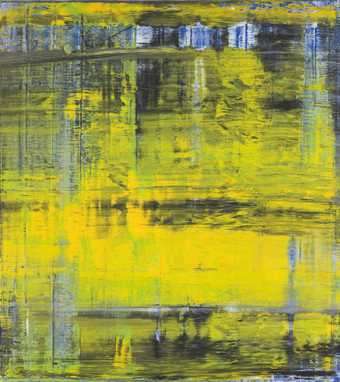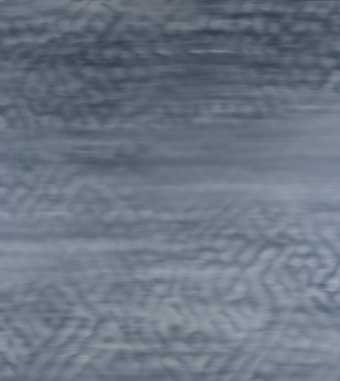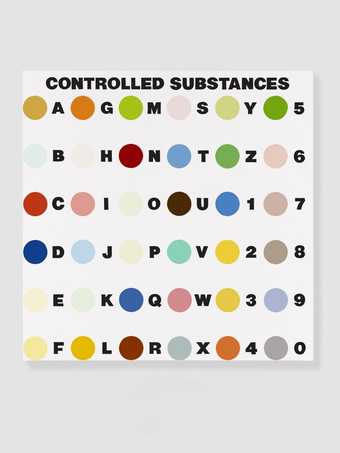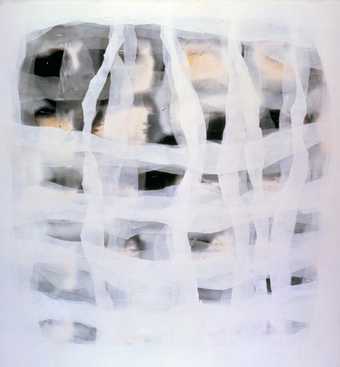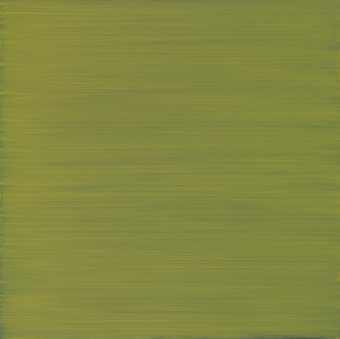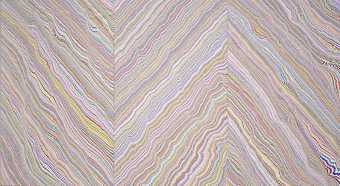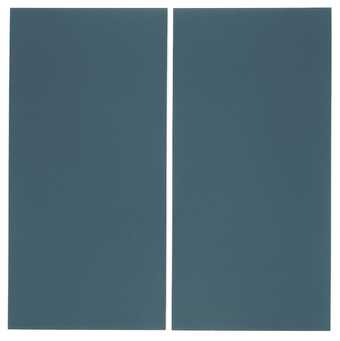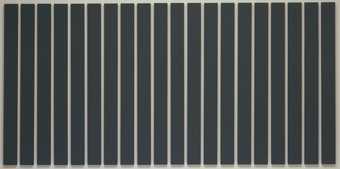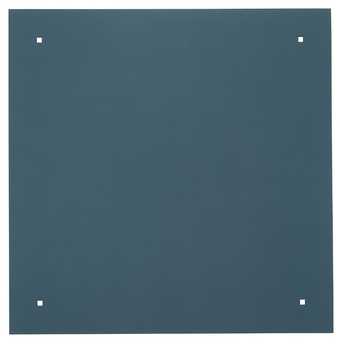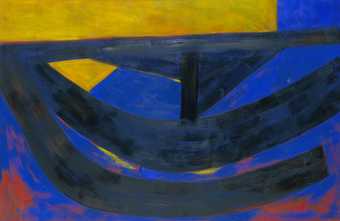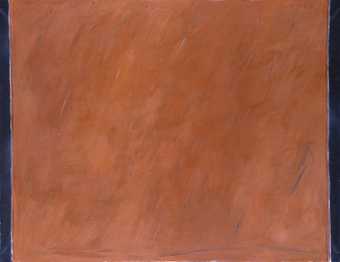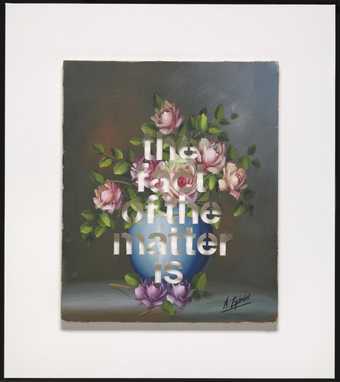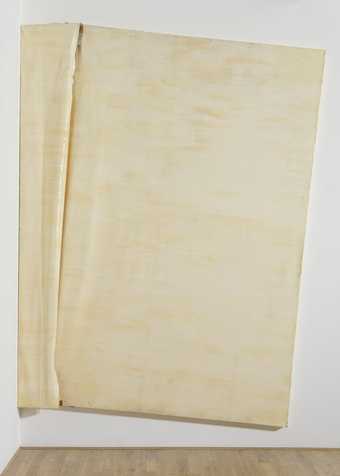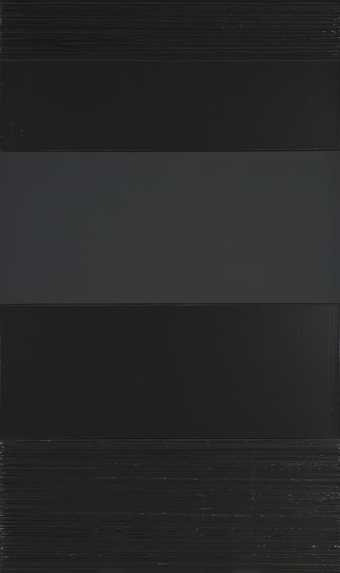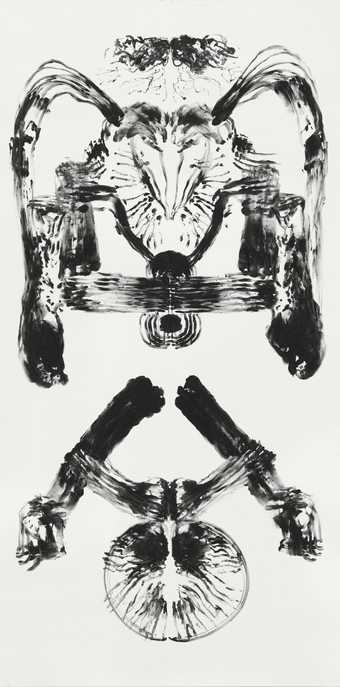
Not on display
- Artist
- Julie Mehretu born 1970
- Medium
- Ink and acrylic paint on canvas
- Dimensions
- Support: 4572 × 3658 mm
- Collection
- Tate
- Acquisition
- Purchased with funds provided by Tiqui Atencio Demirdjian and Ago Demirdjian, Andreas Kurtz and the Tate Americas Foundation 2014
- Reference
- T13997
Summary
Mogamma: Part 3 was made by Julie Mehretu in 2012 as part of a series Mogamma: A Painting in Four Parts shown at Documenta 13, Kassel in the summer of 2012. The series takes its name from the government building in Tahrir Square in Cairo, a building which formed a backdrop for the protests against then President Hosni Mubarak’s regime in early 2011. The Mogamma was constructed in the 1940s and designed by the Egyptian architect Kamal Ismail; it was an administrative centre which became a symbol of the country’s government bureaucracy.
In this monumental painting, which is over four and half metres tall and three and a half metres wide, Mehretu creates a palimpsest of architectural drawings of the Mogamma, as well as of other public buildings and squares associated with public unrest, including Addis Ababa’s Meskel Square and New York’s Zuccotti Park – the site of the ‘Occupy’ protests that took place the year the painting was made. Mehretu worked with a team of assistants to research and accumulate images of these sites and to derive plans and elevation drawings from them using computer programs. The digital images were then projected onto the surface and traced over. They overlap and intermingle, denying the viewer the possibility of comprehending the architectural situation as would be possible in a drawing produced by an architect for a client. Although parts of the architecture can be picked out and recognised in different areas of the canvas, viewers have to abandon the desire to fully master what they see.
After the tracing, Mehretu covers the surfaces of her works with other kinds of drawing and painting. Using a brush, she applies clusters of dabs which swarm and billow in cloud-like formations. She hand-paints swooping coloured lines which stand out from the pencil and areas of black paint, giving the work a dynamic compositional structure; and silkscreens grids of grey pixels and transparent coloured shapes, such as the yellow triangle in the top right corner of this work. These coloured areas, while recalling the language of modernist abstraction, are also derived from her memory of images of flags and banners held aloft by protestors in the sites.
A complex memorial to sites of state oppression and communal resistance, the Mogamma paintings also deny the viewer a focus for, or overt subject of, mnemonic activity. Offering fleeting glimpses of recognisable spatial situations, it nevertheless refuses to anchor the viewer in a secure space, and indeed through its scale creates a different kind of environmental situation and experience. Mehretu explains her motivations for using images of architecture as her subject matter: ‘I think architecture reflects the machinations of politics, and that’s why I am interested in it as a metaphor for those institutions. I don’t think of architectural language as just a metaphor about space, but about spaces of power, about ideas of power.’ (Quoted in Brian Dillon and Joan Young, Julie Mehretu: Grey Area, exhibition catalogue, Deutsche Guggenheim, Berlin 2009, p.29). As for what her transformations of images of state institutions amount to, the critic T.J. Demos wrote in the catalogue of Mehretu’s exhibition at White Cube, London in the spring of 2013 (in which this painting was shown) that the paintings ‘open up a third space of conceptual and visual potentiality, where systems defy a coherent plan or unified cartography’ (see White Cube and Marian Goodman Gallery 2013).
Further reading
Douglas Fogle and Olukemi Ilesanmi (eds.), Julie Mehretu: Drawing into Painting, exhibition catalogue, Walker Art Center, Minneapolis 2003.
Mark Godfrey, ‘Julie Mehretu: Black City’, in Jeffrey Deitch (ed.), The Painting Factory, exhibition catalogue, Museum of Contemporary Art, Los Angeles 2012, pp.110–16.
T.J. Demos, ‘Painting and Uprising: Julie Mehretu’s Third Space’, in Julie Mehretu: Liminal Squared, exhibition catalogue, White Cube, London, and Marian Goodman Gallery, New York 2013.
Mark Godfrey
May 2013
Does this text contain inaccurate information or language that you feel we should improve or change? We would like to hear from you.
Display caption
The Mogamma is the government building in Tahrir Square in Cairo, which formed a backdrop for the protests against Hosni Mubarak’s regime in early 2011. Mehretu has overlaid architectural drawings of the Mogamma with those of other locations associated with public unrest, including Addis Ababa’s Meskel Squre and New York’s Zuccotti Park, the site of the ‘occupy’ protests. Using digital images and projecting them onto the surface of the canvas, Mehretu complicates the drawn plans so that we can no longer see them clearly. The resulting painting could be seen as a memorial to collective sites of communal resistance.
Gallery label, October 2016
Does this text contain inaccurate information or language that you feel we should improve or change? We would like to hear from you.
You might like
-
Gerhard Richter Abstract Painting (809-3)
1994 -
Gerhard Richter Abstract Painting (Skin) (887-3)
2004 -
Damien Hirst Controlled Substance Key Painting
1994 -
Ian McKeever Hartgrove Painting No. 2
1992–3 -
Maria Lalic History Painting 8 Egyptian. Orpiment
1995 -
Peter Davies Small Touching Squares Painting
1998 -
Alan Charlton 2 Part Vertical Painting
1991 -
Alan Charlton 20 Part Line Painting
1991 -
Alan Charlton Painting with Four Square Holes
1991 -
Wilhelmina Barns-Graham June Painting, Ultramarine and Yellow
1996 -
Michael Finn Red Painting
c.1989 -
Amikam Toren Armchair Painting - Untitled (the fact of the matter is)
2006 -
Angela de la Cruz One Painting
1999 -
Pierre Soulages Painting 304 x 181 cm, 9 December 2007
2007 -
Mark Wallinger id Painting 29
2015

